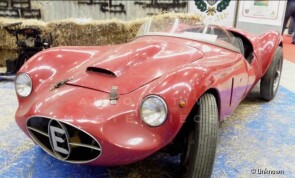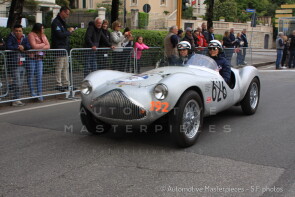
1950 Fiat trasformazione Stanguellini 1100 Sport Internazionale
ON/OFF
Why am I an Automotive Masterpiece?
H. Works cars
C. STANGUELLINI (IT)
L. Limited edition cars
no. 13 manufactured
The history of the Stanguellini brand began in 1900 in Modena from the passion of Francesco Stanguellini. In the early years of the twentieth century, the brand grew in importance by participating in motorcycle races and, above all, by dedicating itself to car processing. From 1936, it entered the production of its own models derived from Fiat and Maserati chassis with the 750, 1100, and 2800. In 1937, the first racing team was formed, which began a series of victories, culminating in first place in its class (50th overall) at the XII Mille Miglia in 1938 with a Stanguellini 750, bringing the team to international recognition. From then on, both national and international successes flourished. In the late forties, the company also produced high-tech car chassis and engines. Stanguellini is the perfect postcard of Postwar Italian Renaissance and Ingenuity. The cars achieved significant improvements and results but, at this point in the story, were still barely known as “Stanguellini” and mostly as “derivazione FIAT”. After WWII, the Stanguellini cars were absolute winners. With the changing of the Sport rules, Vittorio Stanguellini could develop his cars again. They were barely the FIATs of the beginning: around a highly reworked aspirated engine, a rigid tubular chassis was built by Gilco on the design of engineer Alberto Massimino. For the bodywork, pure aerodynamics was conceived with attention to the agility of the car: this way, the “Siluro” with motorcycle fenders and the “Barchetta” were born. Every component was reworked. The engine developed from a Single Cam-In-Block with pushrods to a double Overhead Cam. Heads themselves were already changed from cast iron to light alloy. Gentle and inventive, Vittorio always worked in a family-dimension, with men like the foreman-tester Renato Cornia and professionals who were first of all friends. This was happening right in the heart of Modena, in a small cluster of streets, while a few hundred meters away, Ferrari and Maserati were rising to the stars. But, as they say, with great respect for each other.
The Sport with a 1100 cc engine was a car developed by Vittorio Stanguellini in the mid-1930s to compete in the Sport Nazionale category. Starting with a FIAT 508C chassis and engine, Stanguellini built his car according to the rules of the category, but with meticulous attention to detail and blueprinting, incorporating innovative ideas such as moving the engine to the center of the car to improve weight balance and focusing on aerodynamics. After the war, racing resumed. The year 1947 was the golden year for Scuderia Stanguellini: successes multiplied, sometimes even ahead of the powerful Ferraris. The 1100 model was renewed, transitioning from Sport Nazionale to Sport Internazionale. From 1947 to 1957, the small and fast barchettas saw radical and continuous technical evolution: the chassis were entirely made in-house using high-strength steel tubes to achieve good rigidity and reduced weight. The suspensions and the rear axle remained derived from Fiat. In 1949, the first twin-cam head for the 1100 engine was built from scratch, which also required complex modifications to the original Fiat engine block. The twin-cam engines (1100 and 750 cc) became the flagship products of the Modenese manufacturer, for which it is known in the automotive world.
The Fiat trasformazione Stanguellini 1100 Sport Internazionale with chassis no. *CS01114* was completed in the early months of 1950. Like the other examples of this model, it has a tubular chassis and a twin-cam engine; the bodywork, also made in Stanguellini, is an aluminum barchetta type. Owned by Vittorio Stanguellini, it was entered by the factory in the 1950 Mille Miglia, with the young driver Sergio Sighinolfi, co-driven by Augusto Gambiani. The car appeared on the starting line with number 626 in a raw livery, with a hammered and unpainted aluminum body; a characteristic of this specimen is the large grill with 34 bars. The side features the writing “Fiat trasformazione Stanguellini.” The sleek shape of the body does not offer much shelter to the drivers, so they had to be covered against the elements. The car completed the Brescia-Rome leg in excellent time: it was 1st in class, with an average speed of 119.031 km/h. But on April 23rd, on the way back to Brescia, shortly after Firenze, on the road to Passo della Futa, the car had an accident injuring the driver and a spectator; among the many surviving documents of the race, it is possible to see the insurance reports, mentioning the chassis number. There is no information about the damage to the car, which was nevertheless repaired in time to participate in the Circuito di Modena where it was first in its heat but was ultimately forced to retire. Chassis no. *CS01114* was sold by Stanguellini in 1952 to Gaetano Di Stefano in Sicily, most likely without the original engine. The car was assigned the details of another Sport based on a Fiat 508C registered to Di Stefano in September 1947, with license plate CT14200, chassis number 200846 “assigned for use,” and engine number 279118. These documents associated with the car were officially canceled in July 1983. In reality, Di Stefano purchased an incomplete Fiat Ermini aluminum twin-cam engine, and it is possible that, after a long period of assembly, he competed in this configuration in some Sicilian races, although there is no evidence of this. In the 1970s, the car was sold with the documents of the Fiat 508C, to Rome where it was restored by Giancarlo Ferri. The car, painted red, had a different front shape, with an oval mouth without "teeth" and a large E (for Ermini) in the center; it is likely that, in the absence of other references, the presence of the Ermini engine led the restorers to misinterpret the identity of the car. On the hood, a large scoop was added to bring more air to the carburetors. It began participating in historic car events in 1985 at the Re-enactment of the Criterium di Roma - Coppa Gallenga and was published in books and specialized press articles. In 2014, it was purchased by collector Giuseppe Bianchini, who conducted research with Gaetano Di Stefano’s son to re-establish historical continuity and attest the correct original chassis stamping. The car was restored to its original livery, with the unpainted body showing the various period welds and the original grille. The philological work was continued by the next owner, Gilberto Focardi, who re-established a correct engine pairing: the Ermini unit was transferred to the Ermini Tinarelli car, while for chassis no. *CS01114* an engine consistent with the original was found at Stanguellini itself; as evidenced by a letter dated September 24, 2014: “Mr. Francesco Stanguellini sells to Mr. Gilberto Focardi a 1100 twin-cam engine number CS0136 to be mounted on Stanguellini car chassis CS 01114, original engine overhauled in the Stanguellini workshops.” Completed by specialist Faralli in 2017, the car received ASI and FIVA certificates. Since 2018, sold to Fine Classic, it has participated in the Mille Miglia re-enactment and is registered with the Registro 1000 Miglia. It was featured in Sandro Binelli’s book: Mille Miglia's Chassis - The Ultimate Opus Volume III. From 2024, it is part of a private collection.





